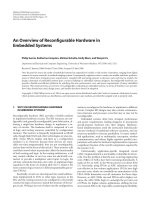ERLANG: AN OVERVIEW IN FOUR PARTS
Bạn đang xem bản rút gọn của tài liệu. Xem và tải ngay bản đầy đủ của tài liệu tại đây (279.13 KB, 108 trang )
<span class="text_page_counter">Trang 1</span><div class="page_container" data-page="1">
Erlang: An Overview in Four Parts
Part 1 – Sequential Erlang
<small>Thanks to Richard Carlsson for the original version of many of the slides in this part</small>
</div><span class="text_page_counter">Trang 2</span><div class="page_container" data-page="2">Erlang Buzzwords
Functional (strict)Single-assignmentDynamically typedConcurrent
Message passingSoft real-time
Fault tolerantShared-nothing
Automatic memory management (GC)
Virtual Machine (BEAM)Native code (HiPE)
Dynamic code loadingHot-swapping code
Multiprocessor supportOTP (Open Telecom Platform) libraries
Open source
</div><span class="text_page_counter">Trang 3</span><div class="page_container" data-page="3">Developed by Ericsson, Sweden
<small>−Experiments 1982-1986 with existing languages</small>
<small>Higher productivity, fewer errors</small>
<small>Suitable for writing (large) telecom applicationsMust handle concurrency and error recovery</small>
<small>−No good match - decided to make their own</small>
<small>1986-1987: First experiments with own languageErlang (after Danish mathematician A. K. Erlang)1988-1989: Internal use</small>
<small>1990-1998: Erlang sold as a product by Ericsson</small>
<small>Development still done by Ericsson</small>
</div><span class="text_page_counter">Trang 4</span><div class="page_container" data-page="4">Erlang at Uppsala University
High Performance Erlang (HiPE) research group
<small>−Native code compiler</small>
<small>back-ends: SPARC, x86, x86_64, PowerPC, PowerPC-64, ARM</small>
<small>−Program analysis and optimization</small>
<small>−Programming and static analysis tools</small>
Most results from the HiPE project have been included in the official Erlang distribution
</div><span class="text_page_counter">Trang 5</span><div class="page_container" data-page="5">Hello, World!
'%' starts a comment
'.' ends each declaration
Every function must be in a module
<small>−One module per source file</small>
<small>−Source file name is module name + “.erl”</small>
':' used for calling functions in other modules
<b><small>%% File: hello.erl</small></b>
<b><small>-spec run() -> 'ok'.</small></b>
<b><small>run() -> io:format("Hello, World!\n").</small></b>
</div><span class="text_page_counter">Trang 6</span><div class="page_container" data-page="6">Running Erlang
The Erlang VM emulator is called '<small>erl</small>'
The interactive shell lets you write any Erlang expressions and run them (must end with '<small>.</small>')The “<small>1></small>”, “<small>2></small>”, etc. is the shell input promptThe “<small>halt()</small>” function call exits the emulator
</div><span class="text_page_counter">Trang 7</span><div class="page_container" data-page="7">There is also a standalone compiler called “<b><sub>erlc</sub></b>”
<small>−Running “</small><b><small>erlc hello.erl</small></b><small>” creates “</small><b><small>hello.beam</small></b><small>”−Can be used in a normal Makefile</small>
</div><span class="text_page_counter">Trang 8</span><div class="page_container" data-page="8">Running a program
Compile all your modules
Call the exported function that you want to run, using “<b><sub>module:function(...).</sub></b>”
The final value is always printed in the shell
<small>−“</small><b><small>ok</small></b><small>” is the return value from </small><b><small>io:format(...)Eshell V5.10.3 (abort with ^G)</small></b>
<b><small>1> c(hello).</small></b>
<b><small>2> hello:run().</small></b>
<b><small>Hello, World!ok</small></b>
<b><small>3> </small></b>
</div><span class="text_page_counter">Trang 9</span><div class="page_container" data-page="9">A recursive function
<small>Variables start with upper-case characters!</small>
<small>'</small><b><small>;' separates function clauses; last clause ends with '.' </small></b>
<small>Variables are local to the function clause</small>
<small>Pattern matching and '</small><b><small>when' guards to select clauses</small></b>
<small>Run-time error if no clause matches (e.g., N < 0)Run-time error if N is not an integer</small>
<b><small>-spec fact(non_neg_integer()) -> pos_integer().fact(N) when N > 0 -></small></b>
<b><small>N * fact(N-1);fact(0) -></small></b>
<b><small>1.</small></b>
</div><span class="text_page_counter">Trang 10</span><div class="page_container" data-page="10">Tail recursion with accumulator
<i><small>The arity is part of the function name:</small></i> <b><small>fact/1≠fact/2</small></b>
<small>Non-exported functions are local to the moduleFunction definitions cannot be nested (as in C)</small>
<small>Last call optimization is performed: the stack does not grow if the result is the value of another function call</small>
<b><small>-spec fact(non_neg_integer()) -> pos_integer().fact(N) -> fact(N, 1).</small></b>
<b><small>fact(N, Fact) when N > 0 ->fact(N-1, Fact*N);</small></b>
<b><small>fact(0, Fact) ->Fact.</small></b>
</div><span class="text_page_counter">Trang 11</span><div class="page_container" data-page="11">Recursion over lists
Pattern matching selects components of the data“_” is a “don't care”-pattern (not a variable)
“<small>[Head|Tail]</small>” is the syntax for a single list cell“<small>[]</small>” is the empty list (often called “nil”)
“<small>[X,Y,Z]</small>” is a list with exactly three elements“<small>[X,Y,Z|Tail]</small>” has three or more elements
<b><small>-spec last([T]) -> T.</small></b>
<b><small>last([Element]) -> Element;last([_|Rest]) -> last(Rest).</small></b>
</div><span class="text_page_counter">Trang 12</span><div class="page_container" data-page="12">List recursion with accumulator
<i>The same syntax is used to construct lists</i>
Strings are simply lists of Unicode characters
<small>−</small> <b><small>"Hello" = [$H, $e, $l, $l, $o] = [72,101,108,108,111]</small></b>
<b><small>reverse(Tail, [Head|Acc]);reverse([], Acc) -></small></b>
<b><small>Acc.</small></b>
</div><span class="text_page_counter">Trang 13</span><div class="page_container" data-page="13">Arbitrary-size integers (but usually just one word)#-notation for base-N integers
$-notation for character codes (<small>ISO-8859-1</small>)
Normal floating-point numbers (standard syntax)
<small>−cannot start with just a '.', as in e.g. C</small>
<b><small>3.14159266.023e+23</small></b>
</div><span class="text_page_counter">Trang 14</span><div class="page_container" data-page="14">Must start with lower-case character or be quotedSingle-quotes are used to create arbitrary atomsSimilar to hashed strings
<small>−Use only one word of data (just like a small integer)−Constant-time equality test (e.g., in pattern matching)−At run-time: atom_to_list(Atom), list_to_atom(List)</small>
</div><span class="text_page_counter">Trang 15</span><div class="page_container" data-page="15">Tuples are the main data constructor in ErlangA tuple whose 1<sup>st</sup> element is an atom is called a
<i>tagged tuple - this is used like constructors in ML</i>
<small>−Just a convention – but almost all code uses this</small>
The elements of a tuple can be any values
At run-time: <b><small>tuple_to_list(Tup)</small></b>, <b><small>list_to_tuple(List){}</small></b>
</div><span class="text_page_counter">Trang 16</span><div class="page_container" data-page="16">Other data types
All terms are ordered and can be compared with <, >, ==, =:=, etc.
</div><span class="text_page_counter">Trang 17</span><div class="page_container" data-page="17">Type tests and conversions
Note that <b><sub>is_list</sub></b> only looks at the first cell of the list, not the rest
A list cell whose tail is not another list cell or an empty list is called an “improper list”.
<small>−Avoid creating them!</small>
Some conversion
functions are just for debugging: avoid!
<small>−</small> <b><small>pid_to_list(Pid)is_integer(X)</small></b>
<b><small>is_list(X) % [] or [_|_]atom_to_list(A)</small></b>
<b><small>list_to_tuple(L)binary_to_list(B)term_to_binary(X)binary_to_term(B)</small></b>
</div><span class="text_page_counter">Trang 18</span><div class="page_container" data-page="18">Built-in functions (BIFs)
Implemented in C
All the type tests and conversions are BIFsMost BIFs (not all) are in the module “<b><sub>erlang</sub></b>”Many common BIFs are auto-imported (recognized without writing “<b><sub>erlang:</sub>...”)</b>
Operators (+,-,*,/,...) are also really BIFs
<b><small>tuple_size(Tuple)element(N, Tuple)</small></b>
<b><small>setelement(N, Tuple, Val)abs(N)</small></b>
<b><small>spawn(Function)exit(Term)</small></b>
</div><span class="text_page_counter">Trang 19</span><div class="page_container" data-page="19"><small>−Application programs</small>
<small>GUI system (gs, wx)</small>
</div><span class="text_page_counter">Trang 20</span><div class="page_container" data-page="20">Boolean and/or/xor are
<i>strict (always evaluate </i>
both arguments)
Use <b><small>andalso</small></b>/<b><small>orelse</small></b> for short-circuit evaluation“<small>=:=</small>” for equality, not “<small>=</small>”We can always use
parentheses when not absolutely certain about the precedence
<b><small>%% the usual operators</small></b>
<b><small>List1 ++ List2</small></b>
</div><span class="text_page_counter">Trang 21</span><div class="page_container" data-page="21">Fun expressions
Anonymous functions (lambda expressions)
<small>−Usually called “funs”</small>
Can have several
arguments and clausesAll variables in the
<i>patterns are new</i>
<small>−</small> <i><small>All variable bindings in the fun are local</small></i>
<small>−</small> <i><small>Variables bound in the environment can be used in the fun-body</small></i>
<b><small>F1 = fun () -> 42 end42 = F1()</small></b>
<b><small>F2 = fun (X) -> X + 1 end42 = F2(41)</small></b>
<b><small>F3 = fun (X, Y) ->{X, Y, F1}end</small></b>
<b><small>F4 = fun ({foo, X}, Y) ->X + Y;</small></b>
<b><small>({bar, X}, Y) ->X - Y;</small></b>
<b><small>(_, Y) ->Y</small></b>
<b><small>F5 = fun f/3</small></b>
<b><small>F6 = fun mod:f/3</small></b>
</div><span class="text_page_counter">Trang 22</span><div class="page_container" data-page="22">Pattern matching with '='
Successful matching binds the variables
<small>−But only if they are not already bound to a value!−A new variable can also be repeated in a pattern−Previously bound variables can be used in patterns</small>
Match failure causes runtime error (badmatch)
<b><small>Tuple = {foo, 42, "hello"},{X, Y, Z} = Tuple,</small></b>
<b><small>List = [5, 5, 5, 4, 3, 2, 1],[A, A | Rest] = List,</small></b>
<b><small>Struct = {foo, [5,6,7,8], {17, 42}},{foo, [A|Tail], {N, Y}} = Struct</small></b>
</div><span class="text_page_counter">Trang 23</span><div class="page_container" data-page="23">Case switches
<small>Any number of clauses</small>
<small>Patterns and guards, just as in functions</small>
<small>'</small><b><small>;</small></b><small>' separates clausesUse “_” as catch-all</small>
<small>Variables may also begin with underscore</small>
<small>−Signals “I don't intend to use the value of this variable”</small>
<small>−Compiler won't warn if this variable is not used</small>
<small>• OBS: Variables may be already bound in patterns!</small>
<b><small>case List of</small></b>
<b><small>[X|Xs] when X >= 0 ->X + f(Xs);</small></b>
<b><small>[_X|Xs] ->f(Xs);[] -></small></b>
<b><small>0;_ -></small></b>
<b><small>%% boolean switch:</small></b>
<b><small>case Bool of</small></b>
<b><small>true -> ... ;false -> ...end</small></b>
</div><span class="text_page_counter">Trang 24</span><div class="page_container" data-page="24">If switches and guard details
Like a case switch without the patterns
and the “<b><small>when</small></b>” keywordNeed to use “<b><small>true</small></b>” as catch-all guard (Ugly!)Guards are special
<small>−Comma-separated list−Only specific built-in </small>
<small>functions (and all operators)</small>
<small>−No side effects</small>
<b><small>0 =< X, X < 256 ->X + f(Xs);</small></b>
<b><small>true ->f(Xs)end</small></b>
<b><small>case 0 =< X and X < 256 oftrue -></small></b>
<b><small>X + f(Xs);false -></small></b>
<small>The above construct is better written as</small>
</div><span class="text_page_counter">Trang 25</span><div class="page_container" data-page="25">The other expressions
<i>are Boolean filters</i>
If there are multiple
generators, you get all combinations of values
</div><span class="text_page_counter">Trang 26</span><div class="page_container" data-page="26">List comprehensions: examples
<b><small>%% quicksort of a list</small></b>
<b><small>qsort([]) -> [];qsort([P|Xs]) -></small></b>
<b><small>qsort([X || X <- Xs, X =< P])++ [P] % pivot element</small></b>
<b><small>++ qsort([X || X <- Xs, P < X]).</small></b>
<b><small>%% generate all permutations of a list</small></b>
<b><small>perms([]) -> [[]];perms(L) -></small></b>
<b><small>[[X|T] || X <- L, T <- perms(L -- [X])].</small></b>
Using comprehensions we get very compact code
<small>...which sometimes can take some effort to understand</small>
Try writing the same code without comprehensions
</div><span class="text_page_counter">Trang 27</span><div class="page_container" data-page="27">Bit strings and comprehensions
Bit string pattern matching:
Bit string comprehensions:
Of course, one can also write:
</div><span class="text_page_counter">Trang 28</span><div class="page_container" data-page="28">Catching exceptions
Three classes of exceptions
<small>−throw: user-defined</small>
<small>−error: runtime errors</small>
<small>−exit: end process−Only catch throw </small>
<small>exceptions, normally (implicit if left out)</small>
Re-thrown if no clause matches
catch-“<small>after</small>” part is always run (side effects only)
<b><small>not_found -></small></b>
<b><small>use_default(X);exit:Term -></small></b>
<b><small>%% with 'of' and 'after'</small></b>
<b><small>try lookup(X, File) ofY when Y > 0 -> f(Y);Y -> g(Y)</small></b>
<b><small>close_file(File)end</small></b>
</div><span class="text_page_counter">Trang 29</span><div class="page_container" data-page="29">Old-style exception handling
“<small>catch Expr</small>”
<small>−Value of “Expr” if no exception</small>
<small>−Value Xof “throw(X)”for a throw-exception−“{'EXIT',Term}” for </small>
<small>other exceptions</small>
Hard to tell what
happened (not safe)Mixes up errors/exitsIn lots of old code
<b><small>Val = (catch lookup(X)),case Val of</small></b>
<b><small>not_found -></small></b>
<b><small>%% probably thrown</small></b>
<b><small>use_default(X);{'EXIT', Term} -></small></b>
<b><small>handle_exit(Term);_ -></small></b>
<b><small>Valend</small></b>
</div><span class="text_page_counter">Trang 30</span><div class="page_container" data-page="30">Record syntax
Records are just a
syntax for working with tagged tuples
You don't have to remember element order and tuple size
Good for internal work within a module
Not so good in public interfaces (users must have same definition!)
<b><small>{a = 0 :: integer(),b :: integer()}).{foo, 0, 1} = #foo{b = 1}</small></b>
<b><small>R = #foo{}</small></b>
<b><small>{foo, 0, undefined} = R{foo, 0, 2} = R#foo{b=2}</small></b>
<b><small>{foo, 2, 1} = R#foo{b=1, a=2}0 = R#foo.a</small></b>
<b><small>undefined = R#foo.b</small></b>
<b><small>f(#foo{b = undefined}) -> 1;f(#foo{a = A, b = B})</small></b>
<b><small>when B > 0 -> A + B;f(#foo{}) -> 0.</small></b>
</div><span class="text_page_counter">Trang 31</span><div class="page_container" data-page="31">C-style token-level preprocessor
<small>−Runs after tokenizing, but before parsing</small>
Record definitions often put in header files, to be included
Use macros mainly for constants
Use functions instead of macros if you can (compiler can inline)
<b><small>-define(PI, 3.1415926).-endif.</small></b>
<b><small>area(R) -> ?PI * (R*R).</small></b>
<b><small>-define(foo(X), {foo,X+1}).{foo,42} = ?foo(41)</small></b>
<b><small>%% pre-defined macros</small></b>
<b><small>?MODULE?LINE</small></b>
</div><span class="text_page_counter">Trang 32</span><div class="page_container" data-page="32"><b>Dialyzer: A defect detection tool</b>
A static analyzer that identifies discrepancies in Erlang code bases
<small>−code points where something is wrong</small>
</div><span class="text_page_counter">Trang 33</span><div class="page_container" data-page="33"><small>Data races (</small><b><small>-Wrace_conditions</small></b><small>)</small>
Experimental extensions with
<small>−Stronger type inference: type dependencies</small>
<small>−Detection of message passing errors & deadlocks</small>
</div><span class="text_page_counter">Trang 34</span><div class="page_container" data-page="34">How to use Dialyzer
First build a PLT (needs to be done once)
Once this finishes, analyze your application
If there are unknown functions, you may need to add more Erlang/OTP applications to the PLT
<b><small>> dialyzer --build_plt --apps erts kernel stdlib </small></b>
</div><span class="text_page_counter">Trang 35</span><div class="page_container" data-page="35">Erlang: An Overview in Four Parts
Part 2 – Concurrency and Distribution
<small>Thanks to Richard Carlsson for most of the slides in this part</small>
</div><span class="text_page_counter">Trang 36</span><div class="page_container" data-page="36"><i>Each process has a unique Process Identifier </i>
<i>(“Pid”), that can be used to identify the process</i>
<i>Processes are concurrent (they can run in parallel)</i>
<small>P1</small> <b><small>fib(0) -> 1;fib(1) -> 1;</small></b>
<b><small>fib(N) when N > 0 ->fib(N-1) + fib(N-2).</small></b>
</div><span class="text_page_counter">Trang 37</span><div class="page_container" data-page="37">Erlang processes are implemented by the VM’sruntime system, not by operating system threads
<i>Multitasking is preemptive (the virtual machine </i>
does its own process switching and scheduling)Processes use very little memory, and switching between processes is very fast
Erlang VM can handle large numbers of processes
<small>−Some applications use more than 100.000 processes</small>
On a multiprocessor/multicore machine, Erlang processes can be scheduled to run in parallel on separate CPUs/cores using multiple schedulers
</div><span class="text_page_counter">Trang 38</span><div class="page_container" data-page="38">Concurrent process execution
Different processes may be reading the same program code at the same time
<small>−They have their own data, program point, and stack –only the text of the program is being shared (well, almost)−</small> <i><small>The programmer does not have to think about other </small></i>
<i><small>processes updating the variables</small></i>
<b><small>fact(0) -> 1;</small></b>
<b><small>fact(N) when N > 0 ->N * fact(N-1).</small></b>
<small>P4</small>
</div><span class="text_page_counter">Trang 39</span><div class="page_container" data-page="39">Message passing
“<small>!</small><i>” is the send operator (often called “bang!”)</i>
<small>−The Pid of the receiver is used as the address</small>
<i>Messages are sent asynchronously</i>
<small>−The sender continues immediately</small>
Any value can be sent as a message
<b><small>Pid2 ! Message</small></b>
</div><span class="text_page_counter">Trang 40</span><div class="page_container" data-page="40">Message queues
<i>Each process has a message queue (mailbox)</i>
<small>−Arriving messages are placed in the queue</small>
<small>−</small> <i><small>No size limit – messages are kept until extracted</small></i>
<i>A process receives a message when it extracts it </i>
from the mailbox
<small>−Does not have to take the first message in the queueP2</small>
<small>Newest</small> <sub>Oldest</sub><small>Mailbox</small>
</div><span class="text_page_counter">Trang 41</span><div class="page_container" data-page="41">Receiving a message
<b>receive expressions are similar to case switches</b>
<small>−Patterns are used to match messages in the mailbox−Messages in the queue are tested in order</small>
<small>The first message that matches will be extracted</small>
<small>A variable-pattern will match the first message in the queue</small>
<small>−Only one message can be extracted each time</small>
<b><small>Msg -> io:format("~w\n", [Msg])end</small></b>
<small>P2Message</small>
</div><span class="text_page_counter">Trang 42</span><div class="page_container" data-page="42">Selective receive
Patterns and guards let a programmer control the priority with which messages will be handled
<small>−Any other messages will remain in the mailbox</small>
The <b>receive clauses are tried in order</b>
<small>−If no clause matches, the next message is tried</small>
<i>If no message in the mailbox matches, the </i>
<i>process suspends, waiting for a new message</i>
<b><small>{foo, X, Y} -> ...;</small></b>
<b><small>{bar, X} when ... -> ...;...</small></b>
<b><small>end</small></b>
</div><span class="text_page_counter">Trang 43</span><div class="page_container" data-page="43">Receive with timeout
A <b>receive expression can have an after part</b>
<small>−The timeout value is either an integer (milliseconds), or the atom </small><b><small>'infinity' (wait forever)</small></b>
<small>−0 (zero) means “just check the mailbox, then continue”</small>
The process will wait until a matching message arrives, or the timeout limit is exceeded
<b><small>Soft real-time: approximate, no strict timing guarantees</small></b>
<b><small>{foo, X, Y} -> ...;</small></b>
<b><small>{bar, X} when ... -> ...after 1000 -></small></b>
<b><small>... % handle timeout</small></b>
<b><small>end</small></b>
</div><span class="text_page_counter">Trang 44</span><div class="page_container" data-page="44">Send and reply
Pids are often included in messages (<b><sub>self()</sub></b>), so the receiver can reply to the sender
<small>−If the reply includes the </small><b><small>Pid of the second process, it </small></b>
<small>is easier for the first process to recognize the reply</small>
<b><small>Pid! {hello, self()},receive</small></b>
<b><small>{reply, Pid, String} ->io:put_chars(String)end</small></b>
</div><span class="text_page_counter">Trang 45</span><div class="page_container" data-page="45">Message order
Within a node, the only guaranteed message order is when both the sender and receiver are the same for both messages (First-In, First-Out)
<small>−In the left figure, m1 will always arrive before m2 in the message queue of P2 (if m1 is sent before m2)−In the right figure, the arrival order can vary</small>
<small>m2P3</small>
</div><span class="text_page_counter">Trang 46</span><div class="page_container" data-page="46">Selecting unordered messages
Using selective receive, we can choose which messages to accept, even if they arrive in a
<b><small>m1 -> io:format("Got m1!")end,</small></b>
<b><small>m2 -> io:format("Got m2!")end</small></b>
</div><span class="text_page_counter">Trang 47</span><div class="page_container" data-page="47">Starting processes
The <b>'spawn' function creates a new process</b>
There are several versions of '<b>spawn':</b>
<small>−</small> <b><small>spawn( fun() -> ... end )</small></b>
<small>can also do </small><b><small>spawn(fun f/0) or spawn(fun m:f/0)</small></b>
<small>−</small> <b><small>spawn( Module, Function, [Arg1, ..., ArgN] )Module:Function/N</small></b> <small>must be an exported function</small>
The new process will run the specified functionThe spawn operation always returns immediately
<small>−The return value is the Pid of the new process−The “parent” always knows the Pid of the “child”−The child will not know its parent unless you tell it</small>
</div><span class="text_page_counter">Trang 48</span><div class="page_container" data-page="48">Process termination
<i>A process terminates when:</i>
<small>−It finishes the function call that it started with−There is an exception that is not caught</small>
<small>The purpose of '</small><b><small>exit</small></b><small>' exceptions is to terminate a process“</small><b><small>exit(normal)</small></b><small>” is equivalent to finishing the initial call</small>
All messages sent to a terminated process will be thrown away, without any warning
<small>−No difference between throwing away and putting in mailbox just before process terminates</small>
The same process identifier will not be used again for a long time
</div><span class="text_page_counter">Trang 49</span><div class="page_container" data-page="49">A stateless server process
<b><small>run() -></small></b>
<b><small>Pid= spawn(fun echo/0),</small></b>
<b><small>Pid! {hello, self(), 42},receive</small></b>
<b><small>{reply, Pid, 42} ->Pid ! stop</small></b>
<b><small>echo() ->receive</small></b>
<b><small>{hello, Sender, Value} -></small></b>
<b><small>Sender! {reply, self(), Value},echo(); % loop!</small></b>
<b><small>stop ->ok</small></b>
<small>{hello,P1,42}{reply,P2,42}</small>
</div>








